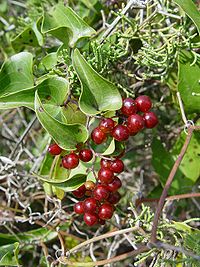Smilax
| Smilax subsp. var. | ||||||||||||||||||||||||||||||||||||||||||||||||||||||||
|---|---|---|---|---|---|---|---|---|---|---|---|---|---|---|---|---|---|---|---|---|---|---|---|---|---|---|---|---|---|---|---|---|---|---|---|---|---|---|---|---|---|---|---|---|---|---|---|---|---|---|---|---|---|---|---|---|

|
|
| ||||||||||||||||||||||||||||||||||||||||||||||||||||||
| ||||||||||||||||||||||||||||||||||||||||||||||||||||||||
- For another plant sometimes called Smilax see Asparagus asparagoides.
Smilax is a genus of about 300-350 species, found in temperate zones, tropics and subtropics worldwide. In China for example about 80 are found (39 of which are endemic), while there are 20 in North America north of Mexico[1]. They are climbing flowering plants, many of which are woody and/or thorny, in the monocotyledon family Smilacaceae, native throughout the tropical and warm temperate regions of the world. Common names include catbriers, greenbriers, prickly-ivys and smilaxes. "Sarsaparilla" (also zarzaparrilla, sarsparilla) is a name used specifically for the Jamaican S. regelii as well as a catch-all term in particular for American species. Occasionally, the non-woody species such as the Smooth Herbaceous Greenbrier (S. herbacea) are separated as genus Nemexia; they are commonly known by the rather ambiguous name "carrion flowers".
Greenbriers get their scientific name from the Greek myth of Krokus and the nymph Smilax.[2] Though this myth has numerous forms, it always centers around the unfulfilled and tragic love of a mortal man who is turned into a flower, and a woodland nymph who is transformed into a brambly vine. (Compare the story of Barbara Allen and sweet William: They buried Barbara in the old church yard / They buried Sweet William beside her / Out of his grave grew a red, red rose / And out of hers a briar.)
On their own, Smilax plants will grow as shrubs, forming dense impenetrable thickets. They will also grow over trees and other plants up to 10 m high, their hooked thorns allowing them to hang onto and scramble over branches. The genus includes both deciduous and evergreen species. The leaves are heart-shaped and vary from 4-30 cm long in different species.
Greenbrier is dioecious. However, only about one in three colonies have plants of both sexes. Plants flower in May and June with white/green clustered flowers. If pollination occurs, the plant will produce a bright red to blue-black spherical berry fruit about 5-10 mm in diameter that matures in the fall.
The berry is rubbery in texture and has a large, spherical seed in the center. The fruit stays intact through winter, when birds and other animals eat them to survive. The seeds are passed unharmed in the animal's droppings. Since many Smilax colonies are single clones that have spread by rhizomes, both sexes may not be present at a site, in which case no fruit is formed.
Smilax is a very damage-tolerant plant capable of growing back from its rhizomes after being cut down or burned down by fire. This, coupled with the fact that birds and other small animals spread the seeds over large areas, makes the plants very hard to get rid of. It grows best in moist woodlands with a soil pH between 5 and 6. The seeds have the greatest chance of germinating after being exposed to a freeze.
| Standard Cyclopedia of Horticulture |
|---|
|
Smilax (ancient Greek name). Liliaceae. The greenbriers, useful for winter greens and outdoor planting. Usually woody climbers with paired tendrils on the base of the petiole; sometimes shrubs or herbaceous perennials, young shoots little branched, old woody shoots becoming much branched above; shoots arising from a rootstock, slow-growing and woody or with large fleshy tubers; in some species with long creeping rhizomes: lower lvs. reduced to scales, the upper simple or slightly lobed, 3-7 (or more) -nerved, deciduous to completely evergreen, usually variable in outline on different types of branches: fls. rather small, dioecious, usually numerous in axillary peduncled umbels; pedicels uniform in length: berries normally globose, 1-6-seeded, blackish or red.—Over 200 species generally distributed over the world. The genus Smilax, of which there are twenty-five species native to the United States, has been used very little in this country for planting in ornamental grounds, its value as a decorative plant having been largely ignored. The vines of the wild plants have been gathered locally for decorations and S. lanceolata, the Florida smilax of the trade, is extensively shipped from the southern states to the northern centers for use in large decorations. Most of the common woody species of the North are unsuited for planting in restricted areas as they spread rapidly by underground stems. None of the native species listed below is ordinarily handled by nurserymen. The smilax of florists is Asparagus asparagoides. See p. 3175; also p. 409, Vol. I. S. argyrea, Lind. & Rod. Tender foliage plant: st. wiry, slender, armed with short, stout thorns: lvs. lanceolate, becoming 8-10 in. long, dark green, blotched with gray, 3-nerved, short-petioled: fls. and fr. unknown. Bolivia. I.H. 39:152. J.H. III. 46:77. According to G.F. 8:305 the above species is a robust healthy plant doing well in a moderate temperature and quickly forming ornamental specimens. It should be given a rich, fibrous soil and a light and sunny position. It may be prop. by half-ripe cuttings of the side shoots with 2-3 eyes inserted in a moderately warm bed. This may be any one of a number of S. American species. The variegated foliage is found in practically all of the woody plants of this genus, being strongly developed in S. glauca, S. Bona-nox and S. lanceolata. CH
|
Cultivation
Propagation
Pests and diseases
Species
Selected species: The genus is divided into a number of sections. Section Smilax includes "woody,"[3] prickly vines of temperate North America, for example Cat Greenbrier (S. glauca) and Common Greenbrier (S. rotundifolia)[4]. Section Coprosmanthus includes unarmed herbaceous plants of temperate North America, for example "carrion flowers" like the Smooth Herbaceous Greenbrier (S. herbacea).[4]

[[Image:Starr 020808-0053 Smilax melastomifolia.jpg|thumb|right|Smilax melastomifolia, called hoi kuahiwi on [[Hawaii|HawaiTemplate:Okinai]]]]
Gallery
References
- ↑ Raven & Zhengyi (2000), FNAEC (2002)
- ↑ Mifsud (2002)
- ↑ Being a monocot, members of the Family Smilacacea can not lay down true wood[citation needed]
- ↑ 4.0 4.1 FNAEC (2002)
- ↑ Template:Citation


